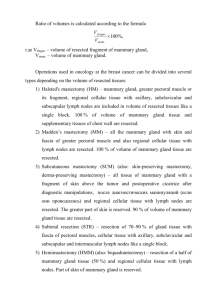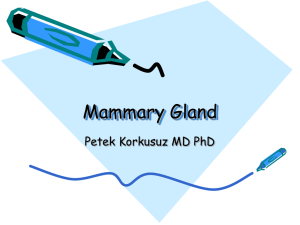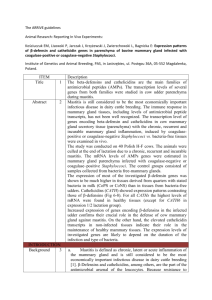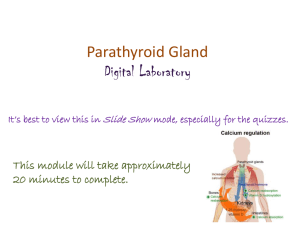Mammary Gland
advertisement
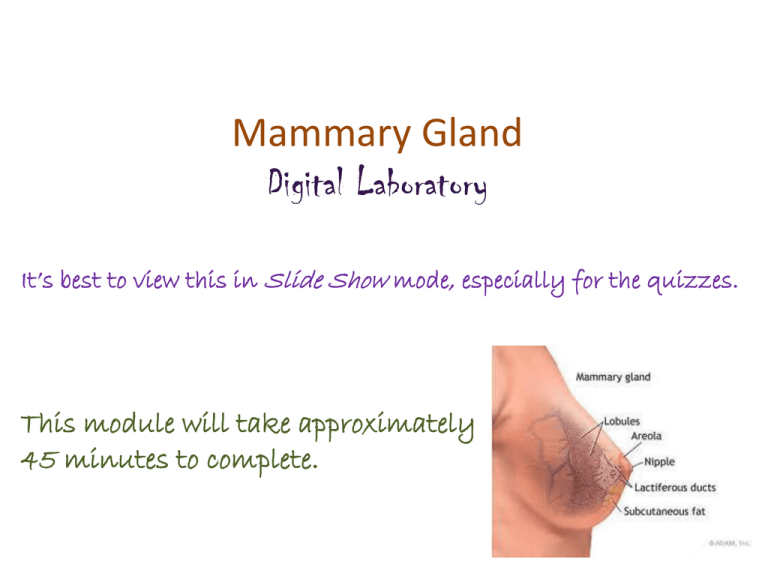
Mammary Gland Digital Laboratory It’s best to view this in Slide Show mode, especially for the quizzes. This module will take approximately 45 minutes to complete. After completing this exercise, you should be able to: •Distinguish, at the light microscope level, each of the following organs and their specific features: •Mammary gland •Lobes and lobules •Acini •Ducts •Stroma •Cells and structures •Secretory cells •Myoepithelial cells •(Plasma cells and other lymphocytes) •Stages •Immature / Inactive •Mammary gland of pregnancy •Lactating mammary gland •Regressing (difficult to distinguish from poorly preserved tissue) •Nipple •Lactiferous ducts / sinuses •Distinguish, at the electron microscope level, each of the following organs and their specific features: •Mammary gland •Acinar cells •Lipid product •Protein product •Myoepithelial cells Each breast contains 12-15 glands, each with a separate opening onto the nipple. The glands can be divided into lobes (blue outline) and lobules (black outline). These contain clusters of secretory cells surrounded by loose connective tissue, which lead to lactiferous ducts. Near the nipple, a dilation of the duct called the lactiferous sinus is a reservoir for milk between feedings. The nipple is a conical elevation which contains sebaceous glands, and smooth muscle for erection. Here we’ll look at 4 different stages of mammary gland development 1. Immature / inactive 2. Mammary gland of pregnancy 3. Mammary gland of breastfeeding 4. Regressing The immature (pre-pubertal) mammary gland is mostly stroma, consisting of connective tissue mixed with some adipose tissue. There are some rudimentary ducts and secretory units. The male and immature female mammary glands are indistinguishable. stroma stroma Video showing immature mammary gland – SL149 Link to SL 149 Be able to identify: •Immature mammary gland •Rudimentary ducts and glands •Stroma •Connective tissue (dense irregular and loose) •Adipose The inactive mammary gland in the female, post-puberty, has some elaboration of the glands and ducts. A select region showing this elaboration is shown in the left image. However, because this increase is relatively modest, most regions of the inactive mammary gland appear like the image to the right. Therefore, it is difficult to distinguish immature and inactive mammary glands with certainty. duct stroma duct stroma duct In this image focusing on a region of glandular tissue, note acinar secretory units (blue oval), with secretory cells. Ducts are indicated on the previous slide. The stroma at this stage is mostly loose or dense irregular connective tissue. stroma Video showing inactive mammary gland – SL150 Link to SL 150 Be able to identify: •Inactive mammary gland (indistinguishable from immature) •Ducts and glands •Stroma •Connective tissue (dense irregular and loose) •Adipose During pregnancy, estrogen and progesterone levels increase significantly. These hormones stimulate extensive elaboration of the ducts and glands, which replace the stromal tissue. Lobes (blue outline) and lobules (green outline) are readily apparent. stroma Enlargement of a secretory region. The acinar cells (green arrow) are cuboidal, with round nuclei and cytoplasmic basophilia. Myoepithelial cells (yellow arrows) have smaller or flattened nuclei on the epithelial side of the basement membrane (light blue arrows). Sparse connective tissue stroma is between the acini. A pregnant woman’s mammary glands produce colostrum, which is similar to milk without the adipose, and contains a mild laxative. Myoepithelial cells of the mammary gland and myoid cells in the testes both are involved in contraction. However, the myoepithelial cells (yellow arrow) are derived from the epithelium, and, therefore, are located on the epithelial side of the basement membrane, while the myoid cells are derived from connective tissue and are positioned on the connective tissue side of the basement membrane. Video showing mammary gland of pregnancy – SL151 Link to SL 151 Be able to identify: •Mammary gland from a pregnant woman •Ducts and glands •Epithelial cells •Acinar cells •Myoepithelial cells •Stroma •Plasma cells After birth, when a woman is lactating, milk is produced. Although there is some proliferation of the ducts and glands, overall, it is often difficult to distinguish mammary glands from pregnant and lactating women based on the amount of secretory tissue. However, lactating women produce milk, which contains substantial lipid. This is evident both within the acinar cells as well as within the lumen of the glands and ducts (arrows). Video showing mammary gland from a lactating woman – SL153 Link to SL 153 Be able to identify: •Mammary gland from a lactating woman •Ducts and glands •Epithelial cells •Acinar cells •Myoepithelial cells •Stroma •(Immune cells - you haven’t had the Infection and Immunity block yet, but you have seen plasma cells a couple times now) After lactation, the secretory units regress. Here, you can see the faint outlines of lobules, with sparse secretory tissue within them. In this image taken at greater magnification, you can see the epithelial component within the lobules is being replaced by connective tissue. Immature or inactive mammary glands do not have elaborate secretory components either. However, in this regressing tissue, you can see the remnant of the lobules – this is not the case with immature or inactive mammary glands. Video showing regressing mammary gland – SL154 Link to SL 154 Be able to identify: •Regressing mammary gland In this electron micrograph taken from the mammary gland of a lactating woman, 2-3 acinar cells are shown. The lumen is toward the bottom, and the stromal connective tissue is at the top. Note large lipid droplets (L), rough endoplasmic reticulum (red outline), milk proteins in lumen (red arrows), and myoepithelial cell (M). Endothelial cell of blood vessel M L L In this image taken from the nipple, note the surface stratified squamous keratinized epithelium (black arrows), dense irregular connective tissue (green arrows), and smooth muscle (yellow arrows). In this image of the same slide in the region just underneath the epithelium, you can see dense irregular connective tissue (green arrows), and smooth muscle (yellow arrows). The lactiferous sinuses (black arrows) have fairly dense connective tissue surrounding them. This is a high power image of a lactiferous sinus. Note the stratified cuboidal / stratified columnar epithelium supported by dense irregular connective tissue. Your objectives ask you to identify lactiferous ducts. The histology of the ducts and sinuses is the same, the difference is in the diameter of the lumen. However, we do NOT expect you to make that call to distinguish the two. Video showing nipple of breast – SL155 Link to SL 155 Be able to identify: •Nipple •Stratified squamous keratinized epithelium •Smooth muscle •Lactiferous ducts The next set of slides is a final quiz for this module. You should review the structures covered in this module, and try to visualize each of these in light and electron micrographs. •Distinguish, at the light microscope level, each of the following organs and their specific features: •Mammary gland •Lobes and lobules •Acini •Ducts •Stroma •Cells and structures •Secretory cells •Myoepithelial cells •(Plasma cells and other lymphocytes) •Stages •Immature / Inactive •Mammary gland of pregnancy •Lactating mammary gland •Regressing (difficult to distinguish from poorly preserved tissue) •Nipple •Lactiferous ducts / sinuses •Distinguish, at the electron microscope level, each of the following organs and their specific features: •Mammary gland •Acinar cells •Lipid product •Protein product •Myoepithelial cells Self-check: Identify the TISSUES in the outlined regions. (advance slides for answers) Smooth muscle Self-check: Identify. (advance slides for answers) Anterior pituitary gland Self-check: Identify. (advance slides for answers) Mammary gland of pregnancy Self-check: Identify cells X and Y, and substances A and B. (advance slides for answers) A X = myoepithelial cell Y = acinar cell A = lipid droplets B = protein B A X Y Self-check: Identify the structures in the outlined regions. (advance slides for answers) Peripheral nerves Self-check: Identify. (advance slides for answers) Regressing mammary gland Self-check: Identify the epithelium on this slide. (advance slides for answers) Stratified squamous keratinized Self-check: Identify the cells indicated by the arrows. (advance slides for answers) Plasma cells (these aren’t very good examples) Self-check: Identify. (advance slides for answers) Lactiferous sinus Self-check: Identify. (advance slides for answers) Lactating mammary gland Self-check: Identify. (advance slides for answers) Immature or inactive mammary gland Self-check: Identify the cells. (advance slides for answers) Myoepithelial cells Acinar cells Self-check: Identify the epithelium on this slide. (advance slides for answers) Transitional epithelium Self-check: Identify outlined structures. (advance slides for answers) duct acinus Self-check: Identify cell X, and structures at arrows. (advance slides for answers) Milk proteins Lipid droplet (yeah, it looks funny) capillary Acinar cell X Self-check: Identify the region indicated by the brackets. (advance slides for answers) Zona fasciculata Self-check: This slide was from a dilation and curettage (D and C) procedure. Which phase of the menstrual cycle is represented on these slides? (they are the same) Link to SL 100A and SL 100B Secretory phase Self-check: This slide was also taken from a dilation and curettage (D and C) procedure. What organ is represented on this slide? (don’t look at the title – cover upper left corner with your hand if you must)) Link to SL 101 cervix




